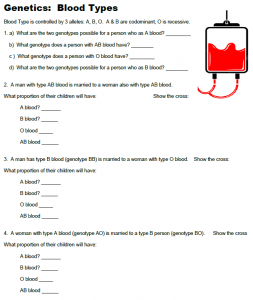
This worksheet provides students with practice problems on multiple allele traits, specifically on how blood types are inherited. The problems focus on the ABO blood groups and students are asked to perform crosses where parents’ blood types are known.
For example, if one parent has type O blood and the other parent has type AB blood, what blood types are possible among their children and in what proportion.
RH factor is not included in this worksheet as it is designed for beginning biology students and that is outside the scope of their lesson. Though, I do talk about RH factor, and how it follows dominant-recessive patterns.
I have also used this worksheet with my anatomy students when studying the circulatory system and blood. Genetics isn’t main part of that curriculum, but it’s a good refresher on what they learned their freshman year.
The Genetics of Blood Types
Blood types are determined by the presence or absence of specific antigens on the surface of red blood cells, classified using the ABO blood group system and the Rh factor. In the ABO system, there are four main blood types: A, B, AB, and O.
A blood has A antigens, while type B has B antigens. Type AB, the universal recipient, has both A and B antigens, and type O, the universal donor, has neither. The ABO gene has three possible alleles: A, B, and O, with A and B being dominant and O recessive.
Additionally, the Rh factor, often referred to as positive (+) or negative (-), is determined by the presence (Rh+) or absence (Rh-) of the D antigen. The Rh gene is inherited separately from ABO, and Rh+ is dominant over Rh-.
A person’s blood type is a combination of these two systems, such as A+, O-, or AB+.
Grade Level: 9-12
Time Required: 15-30 minutes
HS-LS3-3 Apply concepts of statistics and probability to explain the variation and distribution of expressed traits in a population.

